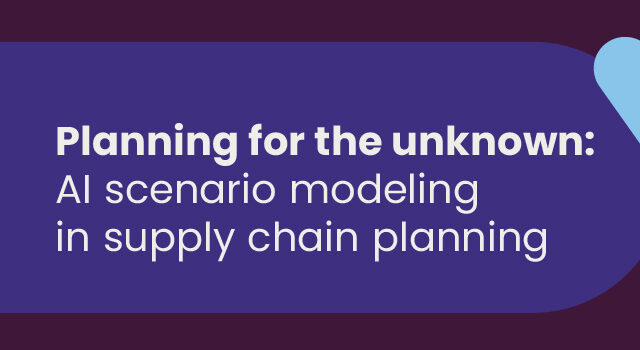Following the Covid-19 pandemic most companies have firsthand experience of the effects of severe supply disruptions and unprecedented demand changes. Unpredictable challenges can happen at any time. Recently, Red Sea piracy stopped vessels from using the route, delaying shipments. Conflicts in the Middle East and Europe have also caused delays. Earthquakes, labor strikes, and severe weather have all disrupted supply routes along the way.
In an uncertain world, accurate demand forecasting is essential to maintain optimal stock levels and efficient supply chains. Accurate forecasts allow you to anticipate trends, enabling quick action and preventing stock-outs. Still, planners must overcome significant challenges to ensure they have the right data they need to create an achievable operational plan.
In this article, we investigate the challenges and uncover strategies for overcoming these issues.
Common demand forecasting challenges
Demand planners face various demand forecasting challenges, which they must overcome for more accurate predictions.
Inconsistent or unpredictable demand patterns
Forecasting would be easy if demand were always stable. In such an environment, historical data would do the job since future sales would follow predictable patterns experienced in the past. Since most demand is inconsistent and unpredictable, forecasting becomes a challenge.
Algorithm-based technology can analyze multiple demand patterns and distinguish between stable and fluctuating demand predictors. It can also analyze large amounts of historical data and demand variables like seasonality, weather patterns, and economic indicators. These technologies recognize and discount outliers to avoid biased forecasts. They also incorporate machine learning, so they improve with time.
External market disruptions
External factors, like economic shifts, political instability, or supply chain disruptions, can cause significant forecasting errors. Therefore, you must incorporate external data, such as market trends and economic indicators, and adjust the forecasts to account for these.
Siloed systems and fragmented data
Many businesses rely on disconnected legacy systems. The result is disjointed information, rather than consolidated data. Information may be left out, inaccurate, or outdated preventing accurate demand forecasts. Integrated systems that combine ERP, CRM, and external data will provide a holistic view of demand. Accurate demand data forms the foundation of more precise and dependable forecasts.
Strategies for overcoming forecasting challenges
Over the years, businesses have developed strategies for overcoming forecasting challenges.
Utilize advanced demand forecasting tools
Advanced demand forecasting tools, like Netstock, can help your business to navigate demand forecasting complexities, by:
- Pattern recognition: Algorithms recognize seasonality and demand pattern changes to anticipate demand shifts.
- Realtime forecast adjustments: They adjust the forecast to match real-time demand changes, enabling a swift response to customer demand.
- Automation: These systems reduce the need for manual input, reducing errors. Automatic data updates improve forecast accuracy.
Short-term and frequent forecasting
Frequent forecasting enables early detection of demand changes allowing you to respond to emerging trends quickly. Frequent forecasting benefits include:
- Improved agility: Businesses can respond quickly to sudden market changes. The result is reduced risk of stockouts and excess inventory.
- Better workforce planning: Better workforce alignment to support demand. With frequent forecasting, you can quickly adjust staffing levels to respond to short-term shifts.
- Optimized inventory management: Businesses can stock the right inventory amounts to meet demand without overcommitting resources.
Collaboration between departments
Close cooperation between sales, marketing, and operations supports more accurate forecasts. Each department brings insights to complement quantitative data. Both demand and supply-side factors will affect forecasts and must be considered.
Sales teams have direct access to customer feedback and trends. Their insights about buying patterns, emerging preferences, and customer concerns can offer valuable context to demand projections. Marketing departments should provide data on upcoming campaigns, promotions, and market conditions that may affect demand. Operations teams offer insights into supply chain constraints, production lead times, and inventory levels.
You can expect the following forecast benefits when departments collaborate:
- Comprehensive demand projections: A broader range of factors enables more precise demand predictions.
- Improved responsiveness: Cross-functional teams have a deeper understanding of external market forces and internal constraints. Combined, these insights can lead to quicker and more informed decision-making.
Planning for unpredictability
In an unpredictable marketplace, businesses must build flexible, proactive strategies into the forecasting process. Strategies should include:
- Dynamic safety stocks: Adopt dynamic safety stock levels that respond to real-time demand and supply changes.
- Scenario planning: Use scenario planning to simulate demand and supply situations and test outcomes. Scenarios can help your business to anticipate challenges and prepare contingencies.
- Monitor key metrics: Businesses must regularly track and refine their forecasting models by measuring the accuracy. Two key metrics are:
- Mean Absolute Percentage Error (MAPE): MAPE measures the average percentage error between forecasted and actual demand. A lower MAPE score indicates better accuracy.
- Forecast bias: Measure whether forecasts consistently over- or underestimate demand. A positive bias means the forecast is too optimistic, while a negative bias suggests it’s too conservative. Forecast bias corrections improve long-term forecast accuracy.
Real-world example: Ubique group optimizes demand forecasting
Ubique Group, a leading U.S.-based provider of furniture and décor for home, office, and commercial spaces, manages over 4,000 products, including customizable SKUs. With over 100,000 possible product combinations, the company’s reliance on large Excel files for inventory and demand forecasting became inefficient. Their complex, seasonal, multi-SKU offerings soon outgrew the limitations of spreadsheets, which were slow and restricted to item-level forecasting.
To overcome these challenges, Ubique Group integrated Netstock with their customized Salesforce ERP system. This integration allowed for more granular forecasting at the SKU, customer, and location levels. Netstock also adjusted forecasts to account for seasonal fluctuations and evolving demand patterns.
As a result, Ubique Group saw a 15% improvement in fill rate and reduced operating inventory by $10 million. Even with the supply chain disruptions and demand shifts caused by COVID-19, the company experienced significant improvements in forecast accuracy.
By adopting Netstock, Ubique Group gained better control of its supply chain, reduced inventory, and enhanced forecast precision—leading to significant operational efficiency gains.
Read the full success story here.
Stay competitive with accurate forecasting
Businesses today face significant challenges in staying ahead and accurate demand forecasting is key to maintaining operational efficiency and optimizing inventory. Thankfully, advanced tools and strategies are available to help you stay competitive.
By leveraging integrated AI-enhanced technology, fostering cross-department collaboration, and building an agile forecasting process, businesses can enhance their forecasting accuracy and responsiveness to market shifts.
Demand and supply planning solutions like Netstock can streamline your forecasting, improve accuracy, and help you better respond to changing market demands. Don’t let supply chain complexities hold you back.




